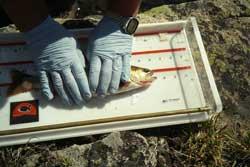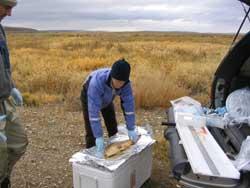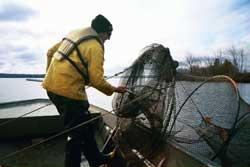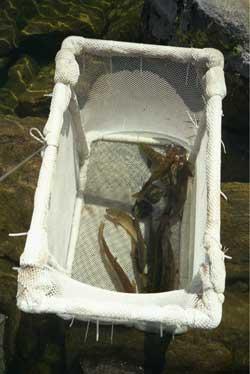National Study of Chemical Residues in Lake Fish Tissue – Sampling Design and Fish Sample Collection
The objective of the National Lake Fish Tissue Study was to estimate the national distribution of the mean levels of 268 persistent, bioaccumulative, and toxic (PBT) chemicals in fish tissue from lakes and reservoirs of the conterminous United States.
Sampling Design

EPA worked with partner agencies in states, tribes, and the federal government to collect fish for the National Lake Fish Tissue Study at 500 lakes and reservoirs in the conterminous United States (lower 48 states) over a period of four years (2000-2003). These lakes were randomly selected in 1999 from River Reach File 3 (RF3), which provided the best available GIS coverage for lakes and reservoirs at that time. RF3 contained over 270,000 lakes that could be potentially selected for the fish study. The Great Lakes and the Great Salt Lake were excluded from this set of lakes before initiating the lake selection process. The lake selection process was based on an unequal probability survey design.
The lakes were divided into six size categories with varying inclusion probabilities to decrease the extent to which small lakes dominated the sample. These size categories (based on surface area where 1 hectare equals about 2.5 acres) were as follows: 1-5 hectares, >5-10 hectares, >10-50 hectares, >50-500 hectares, >500-5000 hectares, and >5000 hectares. The sampling design incorporated spatial constraints to achieve better geographic representation.
The lakes are divided into six size categories with varying inclusion probabilities to decrease the extent to which small lakes dominate the sample. These size categories (based on surface area) are as follows: 1-5 hectares, >5-10 hectares, >10-50 hectares, >50-500 hectares, >500-5000 hectares, and >5000 hectares. The sampling design incorporated spatial constraints to achieve better geographic representation.
Lake Definition

For this study, a lake is defined as a permanent body of water with a permanent fish population that has a surface area of at least 1 hectare (about 2.5 acres), a depth of at least one meter, and at least 1000 square meters of open, unvegetated water.
Target Species
Target fish species were identified to limit the number of species included in the study. They were selected in accordance with EPA’s Guidance for Assessing Chemical Contaminant Data for Use in Fish Advisories, Volume 1: Fish Sampling and Analysis (Third Edition, November 2000) (PDF) (485 pp, 4 MB, About PDF), with preferences cited in EPA’s Field Sampling Plan for the National Study of Chemical Residues in Lake Fish Tissue (September 2002, Revision). Target fish species included two distinct ecological groups of fish, predators (12 species, such as bass or trout) and bottom dwellers (6 species, such as carp or catfish).
Fish Composite Samples

Sampling consisted of collecting two fish composites per site (one composite of predators and another of bottom dwellers). Each composite contained 5 adult fish of the same species and of similar size (so that the smallest individual within the composite was no less than 75% of the total length of the largest individual). A fish composite summary identifies all the fish samples collected for the study. Replicate samples were collected from about 10% of the lakes to estimate sampling variability.
Sample analysis required 560 grams of tissue for analysis of fillets for predator composites and whole bodies for bottom-dweller composites.
Quality Assurance (QA) Program
The project team developed a Quality Assurance Project Plan (QAPP) to support fish sampling activities for this study. The Quality Assurance Project Plan for Sample Collection Activities for a National Study of Chemical Residues in Lake Fish Tissue (May 2000) identifies data quality goals for all sample collection and handling activities and describes the Quality Assurance/Quality Control(QA/QC) techniques employed by field teams to support those goals. EPA ensured consistency in fish collection, handling and shipping through:
- nationwide orientation and training for study participants
- participation of experienced fisheries biologists
- preparation and distribution of a detailed field sampling plan
- implementation of specific Standard Operating Procedures for all sample collection and handling activities
- distribution of identical field sampling materials to all sampling teams
- daily tracking and coordination of sample shipments through a centralized source at the national level
- preparation (filleting and homogenization) of fish tissue samples in a controlled (laboratory) environment
Sampling Schedule
 EPA designed the study to include four years of fish collection. After a brief pilot in the fall of 1999 to test sampling logistics, participants conducted full-scale fish sampling from 2000 through 2003. Each year, field sampling teams collected fish from approximately 125 lakes distributed across the lower 48 states. These field teams collected the majority of the fish samples during the summer and fall of each sampling year. This schedule coincided with the peak period for recreational fishing activity and allowed sampling teams to avoid the spawning period for most target species.
EPA designed the study to include four years of fish collection. After a brief pilot in the fall of 1999 to test sampling logistics, participants conducted full-scale fish sampling from 2000 through 2003. Each year, field sampling teams collected fish from approximately 125 lakes distributed across the lower 48 states. These field teams collected the majority of the fish samples during the summer and fall of each sampling year. This schedule coincided with the peak period for recreational fishing activity and allowed sampling teams to avoid the spawning period for most target species.
Documents
National Lake Fish Tissue Study Sampling Locations
This table provides a list of the 500 lakes and reservoirs sampled for the National Lake Fish Tissue Study. The sampling locations are listed alphabetically by state.
Recommended Target Species for Lakes and Reservoirs (in Order of Preference)
This table identifies the target fish species selected for the National Lake Fish Tissue Study. It is divided into predator (gamefish) species and bottom-dwelling species.
Fish Composite Summary
This summary is divided into separate tables for predator and bottom-dweller composites. Both tables include the common and scientific names for the fish species, their weight and length ranges, and the number and percentage of composites for each species.
Field Sampling Plan for the National Study of Chemical Residues in Lake Fish Tissue (PDF) (40 pp, 744 K, About PDF)
The field sampling plan is a field manual presented in a question-and-answer format that specifies all essential fish collection, handling, and shipping information for state, tribal, and federal sampling teams collecting fish for the National Lake Fish Tissue Study. It includes a project description, detailed standard operating procedures (SOPs) for fish collection, and instructions for completing field forms and labels and for shipping fish samples.
Quality Assurance Project Plan (QAPP) for Sample Collection Activities for a National Study of Chemical Residues in Lake Fish Tissue
The Quality Assurance Project Plan (QAPP) describes the quality assurance/quality control (QA/QC) requirements for collecting, handling, and shipping fish for the National Lake Fish Tissue Study. It was approved by the Office of Science and Technology's (OST's) Quality Assurance Officer in May 2000.
